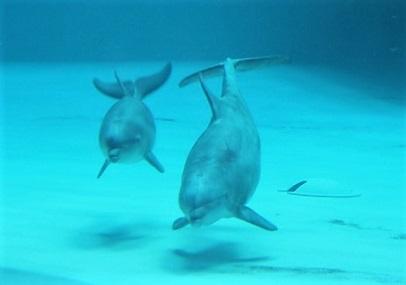Background
Echolocation

Odontocetes (including dolphins) generate sounds in their nasal passage by pushing pressurized air through the two sets of phonic lips, which are located just below the blowhole, in order to produce sonar clicks and whistles (Cranford et al., 1996; Cranford et al., 2011). Cranford et al. (2011) found that the production of whistles requires twice the amount of nasal air volume that it takes to produce click sounds. The main source of echolocation clicks is thought to be the phonic lips on the right side, which is also the bigger one of the two. However recent studies have found that sonar clicks in the bottlenose dolphin may also be generated by the left set of phonic lips (Cranford et al., 2011). The echolocation clicks from the phonic lips are transmitted through the fatty melon which is located on the forehead of the dolphin. The melon functions as an acoustic lens and shapes the sounds into a narrow beam (Au, 1993; Au et al., 2012; Cranford et al., 2011; Cranford et al., 2014; Lemerande, 2002; Starkhammar et al., 2010) which is directed towards the object of investigation. The central part of the beam which is directed directly towards the object is called the core beam, while the part of the beam which is on both sides of the core beam is called the periphery beam. The clicks in the core beam are dominated by high frequencies, often >100kHz, whereas those in the periphery contain more low frequencies (Au, 1993). When the echoes return they are picked up through the thin walled area in the lower jaw (called the acoustic window), and directed to the tympanoperiotic complex (TPC) (Cranford et al., 2010) through the mandibular fat body (which is a fatty tissue structure) (Cranford, et al. 2011).
Echolocation is a big part of the dolphin’s life in the wild. As light waves rapidly decay in water the dolphins can only use their vision at very short distances under the water surface, in which case they have to rely more on their hearing and echolocation skills when investigating their surroundings further away (Dubrovski, 2004). Dolphins use echolocation for various purposes such as; navigation, detecting and catching prey and avoiding predators (DeLong et al., 2014). The ability to echolocate enables dolphins to discriminate between different preys and objects (Harley et al., 2003; Helweg et al., 2003; Kloepper et al, 2014). Dolphins often predate on fish which hide in seagrass beds, such as pinfish, pigfish, mojarra and mullet (Rossman et al., 2015). In such an environment the ability to discriminate between the fish and the seagrass through echolocation is advantageous. When echolocating towards the fish it is the swim bladder (which is air filled) of the fish which provides the echo (Rossman et al., 2015). From the returning echo the dolphin can detect the location of the fish, the fish species as well as the distance from the fish.
Although echolocation is such an important natural behaviour and used for many different vital processes in the lives of dolphins, dolphins do not get much outlet for this behaviour in captivity as their enclosure usually is quite barren and does not change that often. Except for pool walls and floor, there is not much in the pools which would return echoes to the dolphins.
Aim
In the present study the aim was to evaluate if live fish would be a good echolocation enrichment for dolphins kept in human care, to improve their welfare.
Responsible for this page:
Director of undergraduate studies Biology
Last updated:
06/05/16
